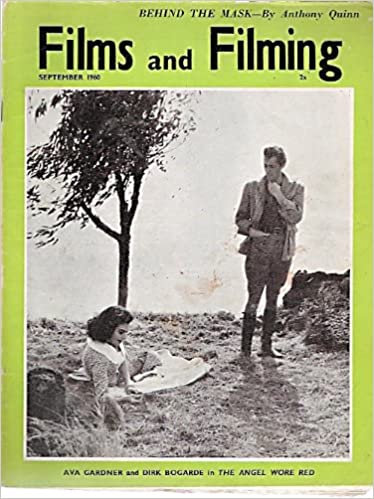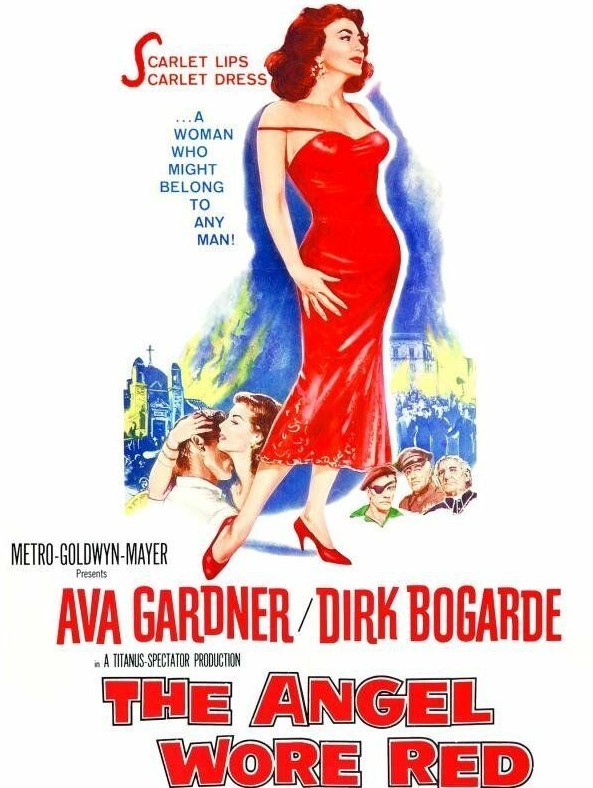Given that this is filmed in black-and-white, it seems a curious title. So I’m assuming the color is a reference to a scarlet woman which, indeed, Ava Gardner (On the Beach, 1959) is, working in a “cabaret” in an unnamed town at the start of the Spanish Civil War. Strangely enough, the decision to shoot in black-and-white works in the actress’s favor. She was one of the last relics of the Hollywood Golden Age when brilliant cinematographers used innovative lighting to capture on screen not so much great beauty but tantalizing emotion.
The close-up was almost exclusively the preserve of actresses who could convey deep feeling with minute changes of expression or simply through their eyes. Here, a couple of joint close-ups prove the point: Gardner’s face illuminated, struggling to contain passion; that of lover Dirk Bogarde (Song without End, 1960) merely the same as always.
This Italian-American production is part homily, part reverential, part brutal. Bogarde plays a priest on the run from the invading Communist forces during the Spanish Civil War. He takes refuge in a cabaret (code for brothel) where he is sheltered by Gardner. He has just denounced his faith so when captured is not executed as an enemy of the state, thus allowing him to begin a relationship with her. They share an unusual type of innocence, Gardner because, as what was known in those days as a woman of easy virtue, she has never known true love, Bogarde, for obvious reasons, the same. Their trembling acceptance of this wondrous state of affairs is the beauty of the film. No one can portray a fallen woman like Gardner, but even as a mature woman her steps towards true love are hesitant, almost believing it is tucked away beyond the rainbow far out of reach, while inner conflict had become central to the Bogarde screen persona.

The love story which would surely in any case have a tragic outcome unfortunately too often plays second fiddle to a subsidiary tale of safeguarding a sacred relic – about whose importance, strangely enough, both sides are agreed – and of arguments between various other political characters over the conflict. Joseph Cotten as a cynical journalist – are there any other kind? – bears testimony to the opposing perspectives while Vittorio de Sica has a glorious cameo as a no-nonsense general who nonetheless deplores the “dirty” war. Neither side comes out well in the war, the Communists, like a mob storming Dracula’s castle, destroy the cathedral, the Republicans committed to killing all prisoners so as not to hold up the advance of their troops. Only the clergy retain their principles even when tortured.
Writer-director Nunnally Johnson had good reason for choosing to film in black-and white – it permitted use of newsreel footage of diving Stuka bombers and more importantly since much of the story takes place at night it creates a haunted background of dark alleys. Color would have destroyed such a vision. You could argue there is artistic purpose here, filming a country which has fallen into spiritual darkness. But that would not be true of the star – black-and-white allows rare opportunity to show what the camera adores in Gardner, her face, even in repose, absorbing the light, as if she were, indeed, redemption.

Johnson really had quite a career as a writer; this seems to suggest he could cut his cloth to suit his purpose. Never was a huge fan of Ava, but maybe I haven’t been looking in the right places…
LikeLiked by 1 person
Anyone who could shift from this to The Dirty Dozen certainly demonstrated versatility. Gardner was sometimes hit or miss but generally worth the price of admission.
LikeLiked by 1 person
Black and white has always fascinated me. Whether it be used to reflect a mood, or for artistic purposes, or even just to get past the Hays Code, it creates a really unique and interesting atmosphere. Glad it seemed to work here.
LikeLiked by 1 person
I always thought it guided emotion far better than colour. The eye was not so easily distracted. I give a lecture where I talk about how Greta Garbo quite often in close-up with minimal dialogue carries a three-minute death scene in Queen Christina. The old directors knew men did little in close up but with a woman you could extract far more emotion.
LikeLiked by 1 person